Tempura Recipes: Crispy & Delicious

How can a simple Tempura dish turn everyday veggies and seafood into a crispy treat? It shows the heart of Japanese food.
Tempura started in the 16th century with Portuguese missionaries in Japan. It’s now a key part of Japanese food. The name “tempura” comes from “tempora,” meaning fasting days. It’s loved for its light, crispy feel and is quick to make.
For a basic tempura batter, you need ¾ cup all-purpose flour, ½ cup potato starch, 1 large egg, ¼ cup chilled vodka, and ¾ cup chilled carbonated water. To get that crispy feel, fry at 350°F (177°C). Knowing how long to fry seafood or veggies is key.
This guide will teach you how to make perfect tempura. You’ll learn cooking techniques, traditional recipes, and how to avoid mistakes. Start now and make your own crunchy bites!
What is Tempura and Its Origins?
Tempura is a special dish from Japan. It’s made by lightly battering and frying seafood and veggies. This makes it crispy but also light.

Understanding Tempura
Tempura started in the 16th century with Portuguese missionaries in Japan. They brought new cooking ways that became tempura. The Japanese made it their own, with a light batter.
It’s all about the right ingredients and how it’s fried. This makes it fluffy and unique.
The History of Tempura
Tempura began in Japan in the 16th century. The name “tempura” comes from the Latin “tempora,” meaning “times.” It was for when Christians didn’t eat meat.
It became street food in the Edo period (1603-1868). Now, chefs like Kondo Fumio make it a fine art.
Key Ingredients in Tempura
The best tempura uses special ingredients. The batter is made from soft flour, cold water, and eggs. Some recipes add vodka or potato starch for extra crispiness.
The batter must be mixed gently. This keeps it light and airy. Seafood like shrimp and veggies like sweet potatoes are common.
| Ingredient | Description |
|---|---|
| Flour | Soft wheat flour is preferred for lightness |
| Water | Ice-cold to achieve the right consistency |
| Eggs | Creates a rich and unified batter |
| Vodka | Occasionally used to enhance crispness |
| Seafood | Shrimp, squid, and various fish |
| Vegetables | Sweet potatoes, eggplant, mushrooms |
Essential Tempura Cooking Techniques
Learning to make tempura starts with knowing how to prepare and fry it. Chef Nicholas Seider says it’s all about the ingredients and their moisture. This affects the final texture a lot.
Preparing Ingredients for Tempura
For tempura, you need fresh ingredients with little moisture. Good veggies are sweet potato, pumpkin, and lotus root. Seafood like shrimp and sakura ebi works well too.
Before frying, cut veggies thinly and seafood clean and devein. This helps them fry evenly and quickly.
Frying Methods: Deep Frying vs. Shallow Frying
There are two ways to fry tempura: deep and shallow. Deep frying means food goes all the way into hot oil, around 350° Fahrenheit. This makes it crispy all over.
Chef Nicholas Seider says fry only 7 or 8 pieces at once. This keeps the oil at the right temperature. Shallow frying uses less oil and needs more turning to cook evenly.
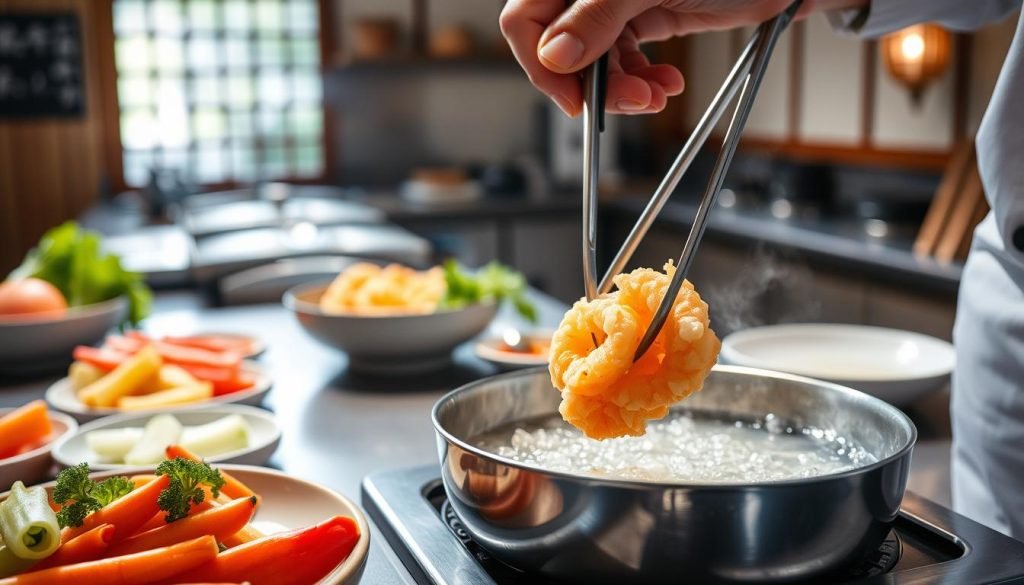
Keeping the oil at the right temperature is key. If batter sizzles loudly when added, it’s good. Use oils like rice bran or grapeseed for frying. Don’t overcrowd the fryer to avoid soggy tempura.
| Aspect | Deep Frying | Shallow Frying |
|---|---|---|
| Oil Usage | High | Low |
| Heat Distribution | Even | Varied |
| Monitoring | Less Frequent | More Frequent |
| Optimal Temperature | 350°F | Slightly Lower |
| Steam Release | More Effective | Less Effective |
Both deep and shallow frying can make great tempura if done right. By using these techniques, you’ll get crispy and tasty tempura every time.
Classic Vegetable Tempura Recipes
Vegetable tempura is a tasty way to enjoy fresh veggies. It’s a simple yet versatile dish from Japan. We’ll look at some favorite recipes that mix tradition and new ideas.
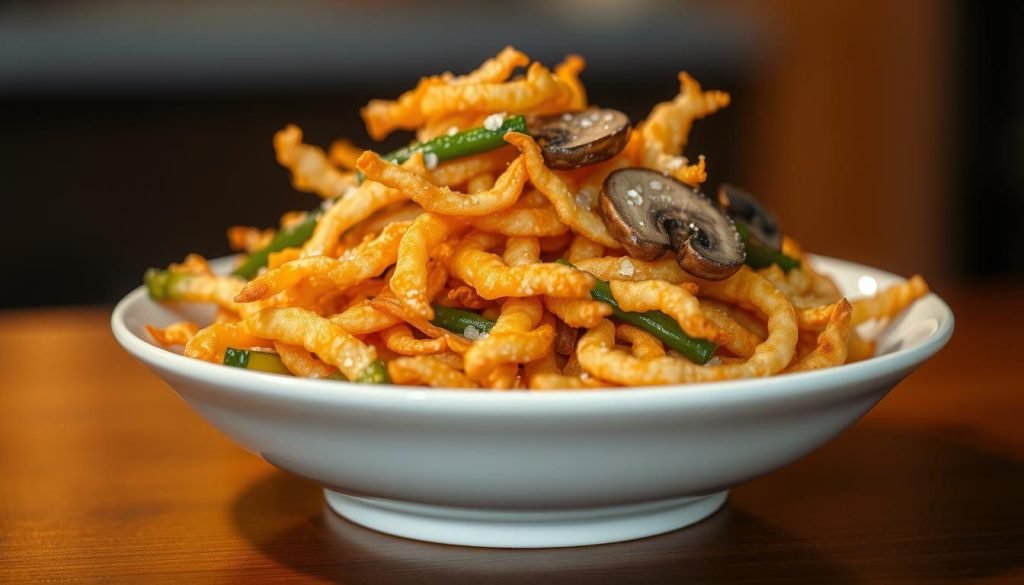
Seasonal Vegetable Tempura
Using veggies in season makes your tempura even better. Here are some great choices and tips:
- Summer Squash: It’s tender and gets crispy when fried. Fry for 2-3 minutes on each side.
- Winter Sweet Potatoes: They’re heartier and sweet. Fry for about 4 minutes for the best crunch.
- Spring Asparagus: Fry it quickly for 60-90 seconds. It stays green and crisp.
Keep the oil hot, between 325 to 350 degrees Fahrenheit. Use a batter with flour, cold water, and beer for a light crunch.
Unique Vegetable Combinations
Try new veggie pairs to make your tempura special. Mixing veggies adds flavor and looks great:
- Lotus Root & Bell Peppers: Lotus root and bell peppers taste great together.
- Snap Peas & Zucchini: Peas and zucchini are a sweet and tasty mix.
For these tasty mixes, make sure your batter is ready. Mix an egg, flour, and ice water. Fry for 2 to 3 minutes on each side. For a tasty sauce, mix soy sauce, maple syrup, and sesame oil.
The secret to great tempura is using fresh veggies and mixing them well. This makes your tempura delicious and pretty.
Traditional Seafood Tempura Variations
Exploring seafood tempura opens up a world of tasty dishes. Shrimp tempura is loved by many, but there are many new ways to make it.
Tempura Shrimp: A Popular Choice
Shrimp and prawn are called “ebi” in Japanese. They are the top picks for tempura. Big shrimp like Japanese tiger prawn and black tiger prawn are juicy and crunchy.
Squid, or “ika,” is also popular. It’s often served with shrimp tempura. Shrimp tempura is loved for its simple taste and perfect texture.
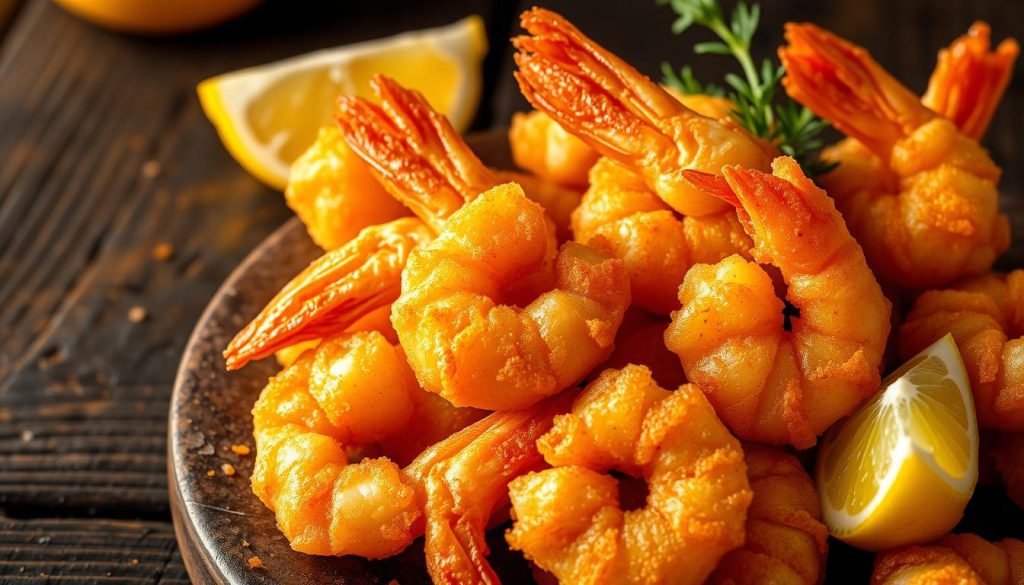
Creative Seafood Selections
There’s more to tempura than shrimp. White fish is mild and great for tempura. It’s a blank canvas for flavors.
Scallops are tender and sweet. Kakiage, a mix of carrot, onion, and small shrimp, is creative and tasty.
Try chikuwa, a fish product, for a jelly-like texture. Chicken tempura, or “toriten,” is a surprise for tempura fans. Seafood tempura keeps getting more exciting.
It’s key to fry seafood at 350-375 degrees Fahrenheit. This ensures a crispy outside and a tender inside.
Here’s a table showing different seafood for tempura:
| Seafood | Flavor Profile | Ideal Tempura Use |
|---|---|---|
| Shrimp (Ebi) | Sweet, Juicy | Shrimp Tempura |
| Squid (Ika) | Tender, Mild | Mixed Seafood Tempura |
| White Fish | Bland, Versatile | Base for Creative Seafood Recipes |
| Scallops | Sweet, Tender | Innovative Tempura |
| Chikuwa | Jelly-like, Mild | Broth Meals, Novel Tempura |
Tips for Achieving Perfect Tempura Batter
To make perfect tempura batter, you need to be careful. Choose the right ingredients and use the right techniques. These tips will help you make your tempura crispy and delicious.
Choosing the Right Flour
Choosing the right flour is key for perfect tempura batter. Use low-protein flours like cake flour for a light and crispy texture. Avoid high-protein flours like bread flour, as they make the batter dense.
| Type of Flour | Protein Content | Recommended Use |
|---|---|---|
| All-Purpose Flour | 10-12% | Moderate lightness, suitable alternative |
| Cake Flour | 7-9% | Best for light and airy batter |
| Bread Flour | 12-14% | Not recommended |
The Importance of Ice-Cold Water
Ice-cold water is very important for tempura batter. It helps keep the batter light and crispy. Keep your flour, water, and egg yolks cold before mixing. Adding ice cubes to the batter keeps it cool.
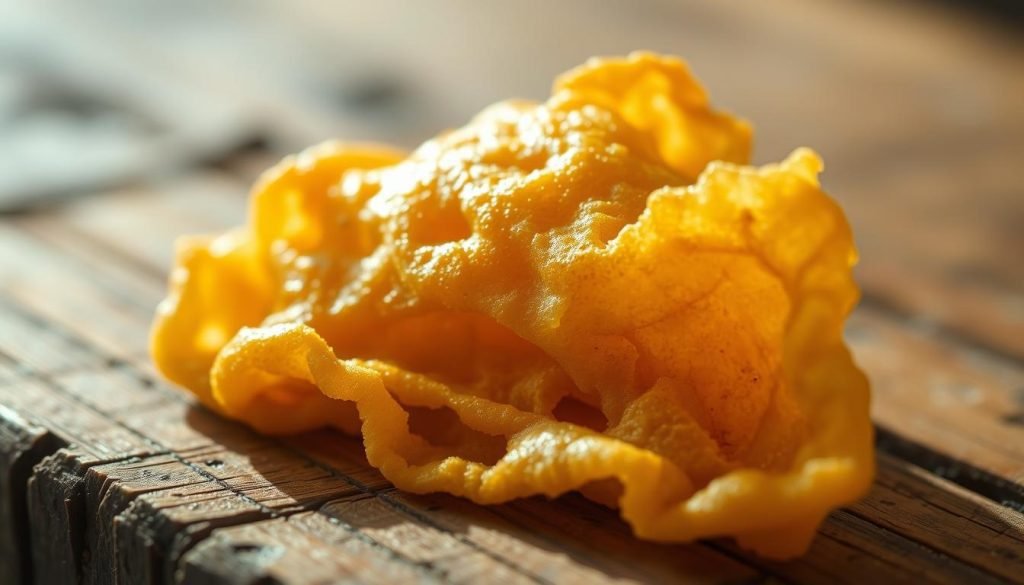
For perfect tempura batter, mix flour, water, and egg yolks in a 1:1 ratio. Sift the flour to avoid clumps. Mix two egg yolks with two cups of cold water, adding ice as needed. Mix for only 15-20 seconds to keep it light and crispy.
Common Mistakes to Avoid with Tempura
Want to make perfect tempura? Stay away from common mistakes. Don’t overmix the batter and keep the cooking temperature right. This will give you crispy, tasty results.
Overmixing the Batter
For great tempura, the batter should be a bit lumpy. Mixing too much can make it tough. A simple batter of flour, water, and egg is best.
Here’s how to mix without overdoing it:
- Mix with chopsticks in big circles.
- Just mix enough to mix the ingredients.
- Let it rest to settle bubbles before frying.

Cooking at Incorrect Temperatures
It’s important to keep the oil at the right temperature. It should be between 350 and 375 degrees Fahrenheit. If it gets too hot, your tempura will be greasy and unsafe.
Here’s how to fry right:
- Fill the pot halfway with oil to avoid spills.
- Use a thermometer to check the oil’s temperature.
- Fry for 2 to 3 minutes on each side until golden.
- Use long chopsticks to handle food safely in hot oil.
Watch the oil temperature and stir it often. This will help your food fry perfectly.
Serving Suggestions for Tempura Dishes
Creating the perfect tempura experience is more than just the batter and frying. Add well-paired tempura dipping sauces and side dishes to make it special.
Dipping Sauces That Complement Tempura
Traditional tempura dipping sauces, like tsuyu, are a classic choice. Tsuyu has soy sauce, rice wine, kombu, katsuobushi, and sake. It gives your tempura a savory taste.
For something different, try ponzu sauce. It’s made from citrus, soy sauce, and dashi. You can also try ginger soy sauce or spicy mayonnaise for a unique flavor.
Pairing Tempura with Rice and Other Side Dishes
Pairing your tempura with the right sides makes it even better. Here are some great options:
- Fried Rice: It’s loved in many Asian cuisines. Fried rice goes well with tempura’s texture.
- Boiled Soba Noodles: Soba noodles are gluten-free and full of nutrients. They’re a light but satisfying choice.
- Ramen Noodles with Sesame Seeds: These noodles are quick to make. They add a hearty and aromatic touch to your meal.
- Grated Daikon: Daikon can be white, purple, green, or red. It adds color and fresh taste to your dish.
- Steamed Vegetables: They keep the meal light and nutritious. Fresh produce is vibrant and full of flavor.
- Japanese Curried Rice: This dish has potatoes, carrots, onions, and proteins. It’s warm and rich, a favorite in Japan.
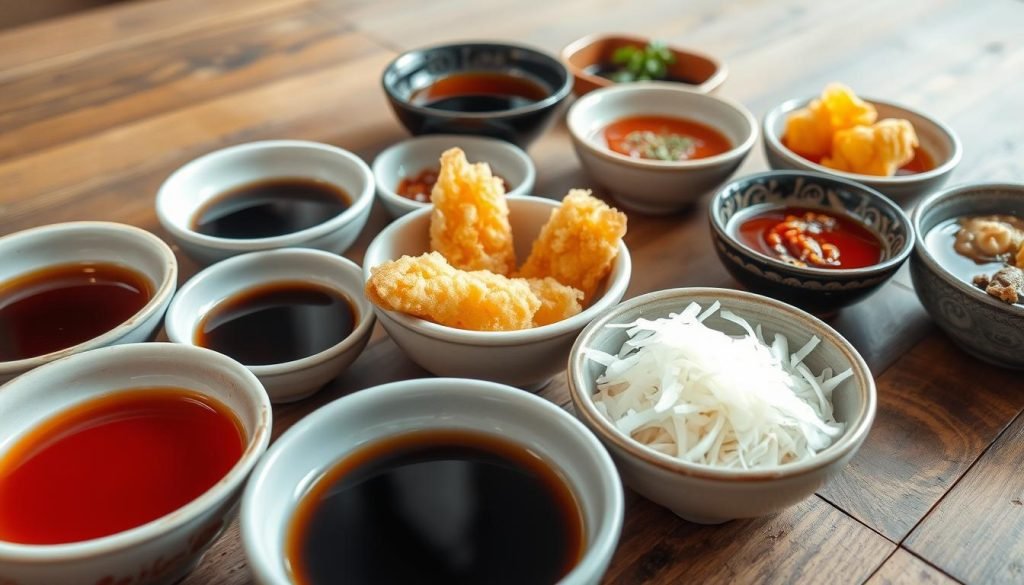
For a full dining experience, mix different tempura serving suggestions. This way, each part of the meal complements the others. Whether you choose traditional or new flavors, these suggestions will make your tempura dish stand out.
Healthier Alternatives to Traditional Tempura
Looking for healthier tempura options? Try new cooking methods and ingredients. Air fryer tempura and gluten-free batter are great choices. They let you enjoy tasty tempura while meeting dietary needs.
Using Air Fryers for Tempura
Using an air fryer is a smart choice. It uses less oil than deep frying. This way, you get crispy, golden tempura without too many calories.
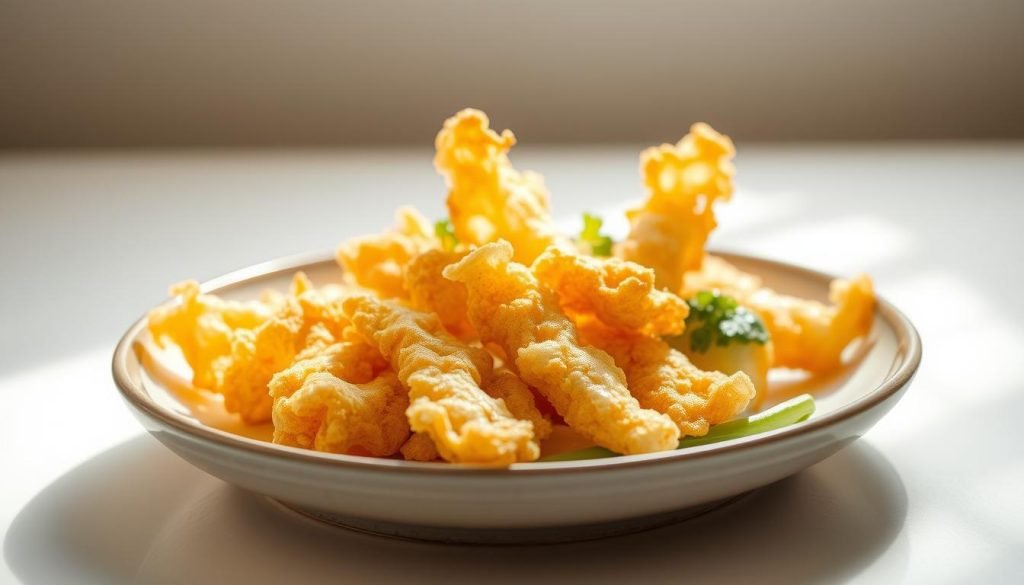
- Preheat your air fryer to 350 degrees Fahrenheit.
- Make the batter with 1 1/4 cups flour, 1 tablespoon cornstarch, 1/8 teaspoon baking powder, and 1/4 teaspoon salt. Mix with 2/3 cups ice-cold water.
- Coat your veggies or seafood with the batter.
- Lightly spray the air fryer basket with cooking spray.
- Put the tempura pieces in the air fryer basket, not touching.
- Air fry for 1 to 2 minutes per side until golden and crispy.
Gluten-Free Tempura Batter Options
Want gluten-free tempura? Use special flour blends. Mix potato starch, tapioca starch, and white rice flour. This makes a batter that’s light and crunchy, just like regular tempura.
- Rice flour: It’s full of protein and carbs, giving you important nutrients.
- Cornstarch: It works just like tempura flour, for the best results.
- Potato starch: It adds a fine texture, making the tempura light and crispy.
By mixing these gluten-free ingredients, you get a tasty tempura batter. It’s as good as the traditional kind, and everyone can enjoy it.
Mastering Tempura: Advanced Techniques
Cooking tempura well is more than basic skills. It takes advanced techniques to make it great. You can add flavors to the batter or ingredients for a twist. Try spices or extracts for different tastes.
For example, smoked paprika or garlic powder can add depth. These flavors surprise and delight your taste buds.
Experimenting with Flavor Infusions
Adding flavors to the batter is an art. It changes how your tempura tastes. Spices like wasabi or citrus zest add unexpected flavors.
For a fancy touch, add vanilla extract or sesame oil. These flavors make your tempura taste even better. They also go well with traditional sauces like tentsuyu.
Ingredient Swaps to Try
The usual tempura batter is flour and cornflour. But, you can try other flours for different tastes. Rice flour or chickpea flour are good for gluten-free options.
Using cold fizzy water or beer makes the batter lighter. It’s like adding air to your tempura.
Try new ingredients like mushrooms, zucchini flowers, or sweet potato slices. They offer unique flavors and textures. Just remember to fry at 170°C-180°C (335°F-350°F) for the best results.
Keep the frying temperature steady. Don’t overcrowd the pot. This way, your tempura will be crispy and golden.